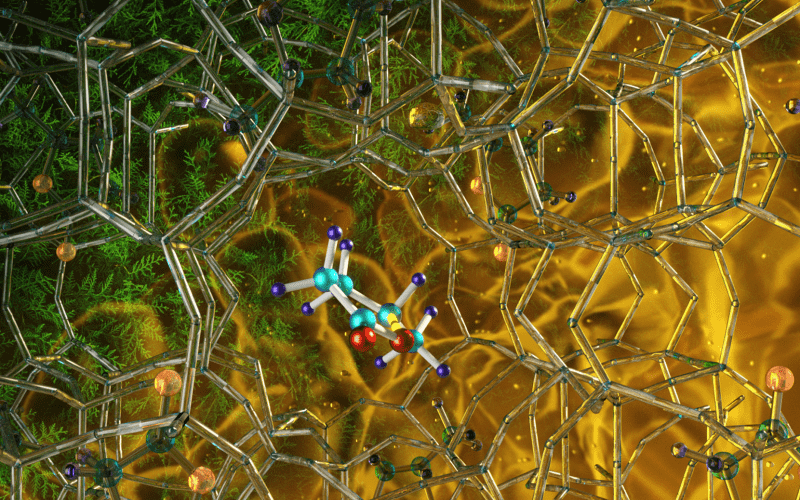Dec 17 2019
A new catalyst designed by a research team changes biomass into fuel sources with exceptionally high efficiency and provides new opportunities for producing next-generation renewable materials. The team was led by the University of Manchester.
 Illustration of the optimized zeolite catalyst (NbAlS-1), which enables a highly efficient chemical reaction to create butene, a renewable source of energy, without expending high amounts of energy for the conversion. Image Credit: ORNL/Jill Hemman.
Illustration of the optimized zeolite catalyst (NbAlS-1), which enables a highly efficient chemical reaction to create butene, a renewable source of energy, without expending high amounts of energy for the conversion. Image Credit: ORNL/Jill Hemman.
At the Department of Energy’s Oak Ridge National Laboratory, neutron scattering experiments were carried out that played a major role in finding out the behavioral and chemical dynamics of a zeolite catalyst to offer information for improving its performance. Zeolite is a normal porous material utilized in commercial catalysis.
The new, improved catalyst, known as NbAlS-1, changes raw materials derived from biomass into light olefins. Light olefins are a group of petrochemicals, like butane, propene, and ethane used for making liquid fuels and plastics. While the optimized catalyst has an extraordinary yield of over 99%, it does not require much energy when compared to its predecessors. The researchers’ study has been published in the Nature Materials journal.
Industry relies heavily on the use of light olefins from crude oil, but their production can have negative impacts on the environment. Previous catalysts that produced butene from purified oxygenated compounds required lots of energy, or extremely high temperatures. This new catalyst directly converts raw oxygenated compounds using much milder conditions and with significantly less energy and is more environmentally friendly.
Longfei Lin, Study Lead Author, University of Manchester
The organic matter, biomass, can be changed and utilized for feedstock and fuel. It is usually extracted from residual agricultural waste—like straw, grass, and wood—that gets decomposed and fed into a catalyst. This catalyst changes the agricultural waste into an energy-rich gas called butene. The petroleum and chemical industries use this butene to make liquid fuels, polymers, and plastics that are otherwise generated from oil.
A chemical reaction usually needs a large amount of energy to decompose the powerful bonds formed by elements such as hydrogen, oxygen, and carbon. Certain bonds may need to be heated up to 1000 °C (over 1800 °F) and more before the strong bonds are broken.
To achieve a greener design, the researchers doped the catalyst by substituting the silicon atoms of zeolite with aluminum and niobium. This replacement produces a chemically unbalanced state that causes the bonds to separate and drastically reduces the requirement for extreme degrees of heat treatments.
The chemistry that takes place on the surface of a catalyst can be extremely complicated. If you’re not careful in controlling things like pressure, temperature, and concentration, you’ll end up making very little butane. To obtain a high yield, you have to optimize the process, and to optimize the process you have to understand how the process works.
Yongqiang Cheng, Researcher, Oak Ridge National Laboratory
Neutrons are ideal for analyzing these types of chemical reactions because of their acute sensitivity to light elements like hydrogen and their deeply penetrating characteristics.
Using the VISION spectrometer available at ORNL’s Spallation Neutron Source, the scientists accurately determined the type of chemical bonds that were present and the way they were functioning based on the vibrational signatures of the bonds. That data enabled the researchers to rebuild the chemical sequence required to improve the performance of the catalyst.
There’s a lot of trial and error associated with designing such a high-performance catalyst such as the one we’ve developed. The more we understand how catalysts work, the more we can guide the design process of next-generation materials.
Sihai Yang, Study Corresponding Author, University of Manchester
The researchers used synchrotron X-ray diffraction measurements at the Diamond Light Source of the United Kingdom to find out the atomic structure of the catalyst. They also made complementary neutron scattering measurements at the ISIS Neutron and Muon Source of Rutherford Appleton Laboratory.
Apart from Lin, Cheng, and Yang, other coauthors of the study include Alena M. Sheveleva, Ivan da Silva, Christopher M. A. Parlett, Zhimou Tang, Yueming Liu, Mengtian Fan, Xue Han, Joseph H. Carter, Floriana Tuna, Eric J. L. McInnes, Luke L. Daemen, Svemir Rudić, Anibal J. Ramirez-Cuesta, and Chiu C. Tang.